Geographically belonging to central Italy, Abruzzo is widely regarded as the northernmost region of Southern Italy, mostly because it used to be part of the Kingdom of the Two Sicilies. The Abruzzo Apennines cover around two thirds of the region’s total area with the other third made up by a flat coastal strip and hilly country. It comes as no surprise that nature is equally multifaceted from divine beaches to huge national parks to large ski areas. Don’t forget the fascinating history dating back to prehistoric times. All of that creates a region you must visit. We have cherry-picked the top 10 sights of Abruzzo for you.
Rocca Calascio
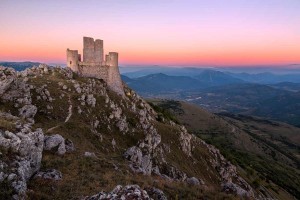
©Bigstock.com/fisfra
The highest-located fortress in the entire Apennines on 1,460 m rises in the middle of Gran Sasso National Park. Initial construction of Rocca Calascio, the castle above the village Calascio, already started in the 10th century. Originally only planned as a single defence tower, it soon turned into an impressive fortification that, however, was never sieged. Rocca Calascio was heavily damaged by two severe earthquakes in 1461 and 1703, yet, in contrast to the village, never rebuilt. Richard Donner shot the final scene of his 1980s movie “Ladyhawke” in this once so imposing castle.
Santa Maria di Collemaggio in L’Aquila
The Romanesque and early Gothic church Santa Maria di Collemaggio in L’Aquila, the now former main church of the Celestine Order, looks like a little jewel-box with alternating blocks of red and white stone on its façade. It was built under Pietro del Murrone, who would later become Pope Celestine V. There’s a glass reliquary casket with the mortal remains of the order’s founder inside the church. Unfortunately, you can’t experience the full glory of Santa Maria di Collemaggio at the moment as it was heavily damaged during the severe earthquake of L’Aquila in 2009. Celestine’s casket was recovered undamaged.
Santo Stefano di Sessanio

©Bigstock.com/luri
Santo Stefano di Sessanio, too, was battered by the aforementioned devastating earthquake of 2009. The hill town on 1,250 m still struggles with the aftermath, yet the town centre continues to exude its allure. Many buildings and monuments were constructed during the reign of the Medici, such as the imposing village portal and the sadly collapsed tower. Fascinating churches, monasteries and palaces adumbrate Santo Stefano di Sessanio’s former glory.
Santuario della Madonna dello Splendore in Giulianova
According to lore, the Virgin Mary appeared to a carpenter in Giulianova on 22 April 1557. When he was mocked and attacked by his fellow men, the Mother of God intervened, protected the carpenter and made water spring from a rock. To this day, the church built on this very site attracts pilgrims from all over Italy. During the annual festival of Mother Mary on April 22nd a statue of the virgin is carried through the village during a ceremonial procession. You need to see this for yourself!
Fortezza di Civitella del Tronto
Italy’s largest fortress, the second-largest of its kind in all across Europe behind Hohensalzburg Castle in the Austrian city of Salzburg, lies above the municipality Civitella del Tronto in the heart of Gran Sasso National Park. In 1556/57 the inhabitants successfully defended their home against François de Guise for months. Rebuilt several times, even having become meaningless for a long time, it regained its original glory after extensive renovation works in 1973. You’ll virtually feel the inhabitants’ prowess when you walk across the ship-formed fortress ground.
Gran Sasso e Monti della Laga National Park
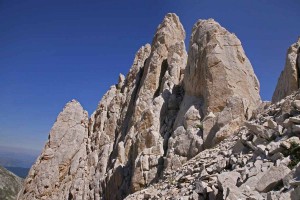
©Bigstock.com/trotalo
Find one of the most beautiful regions in all of Italy around the mountain massif Gran Sasso d’Italia, which has been a nature park since 1991. You’re hiking through one of Europe’s largest conservation areas with a total of 141,341 hectare, most of which lies in the mountainous Apennines. Rare plant and animal species, such as the Abruzzo Edelweiss and the Abruzzo chamois, line your way. Strada Maestra del Parco runs right through the middle of the national park. Now open for tourists, the highway is particularly popular with excursion drivers.
Vasto
Vasto is own of Abruzzo’s few coastal towns. Enjoy yourself on the wide sandy beach, have a little swim, maybe even get a tan. You also need to check out the historic town centre with its many awesome sights. Santa Maria Maggiore was first documented in the late 12th century. It harbours one of many alleged crowns of thorns of Christ. Equally impressive: Castello Caldoresco, the imposing Renaissance fortress.
Ponte del Mare in Pescara
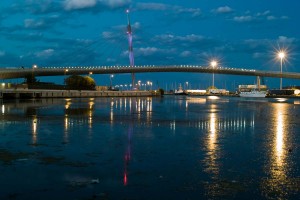
©Bigstock.com/sgar80
What about something modern for a change? Only opened near the end of 2009, two-part Ponte del Mare connects the Riviera coast in the south of Pescara with the northern part of the city. It is the longest pedestrian and cyclist bridge in Italy with an impressive 466 m. Leave your car parked and enjoy a nice walk. At night Ponte del Mare wows you with its play of colours spectacularly contrasting the cityscape and the sea.
Abruzzo National Park
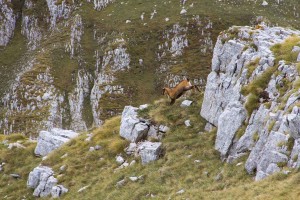
©Bigstock.com/opeth91
Even though it now also has Lazio and Molise in its name, three quarters of the national park are on Abruzzan soil in the province of L’Aquila. The region’s oldest nature park contributes greatly to the preservation of endangered animal species. Its biggest attractions are the brown bears – experts argue over their exact number – wolves, Abruzzo chamois and even a few lynxes. If you like sports, you get to enjoy bike and trekking tours, canoeing, ski action and cross-country skiing in the national park, depending on the season.
Trabocchi Coast
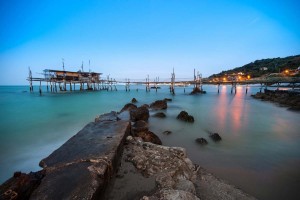
©Bigstock.com/L.Venturelli
Walking along the Abruzzian coast, you’ll probably come across small wooden cabins on piles. These Trabocchi were built for fishing from the Middle Ages onward. You’ll see many such pile dwellings along the 70 km long Trabocchi Coast. Only few of them retained their original form. Some were reinforced with steel and iron structures, others converted into holiday houses and small fish restaurants. There are many grand sandy beaches and overgrown hills accentuating the unique character of these Trabocchi with their vast, sturdy nets.
Be enchanted by Abruzzo’s fascinating nature, retrace the steps of early cultures and find inner peace in the region’s monumental churches – a holiday in the north of Southern Italy always pays off. Find even more grand destinations all over Italy on ZAINOO!